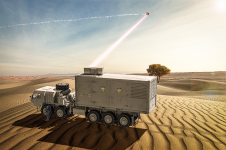US Military Updates & Discussions
- Thread starter BMD
- Start date
You are using an out of date browser. It may not display this or other websites correctly.
You should upgrade or use an alternative browser.
You should upgrade or use an alternative browser.
That's drones taken care off. Note that this is also a phased array solid state laser.

 news.lockheedmartin.com
news.lockheedmartin.com


Lockheed Martin Delivers Its Highest Powered Laser to Date to U.S. Department of Defense
Lockheed Martin (NYSE: LMT) delivered to the Office of the Under Secretary of Defense for Research & Engineering OUSD (R&E) a new benchmark: a tactically-relevant electric 300 kW-class laser ...

A swarm of drones was shown by the US Army. The US Army held mock war games at the Fort Irvine National Training Center. The exercise showed the use of a swarm of drones. About 40 drones were involved in the exercise, and their number will grow over time. Swarms of drones, in the military operations of the near future, will become the main threat on the battlefield.

Swarm Of 40 Drones Over Fort Irwin An Ominous Sign Of What's To Come
The commander of the Army's National Training Center posted a video of a simulated 40-drone swarm attack on a visiting unit at dawn.
Northrop Grumman advances PrSM rocket motor testing
Northrop Grumman has completed a further static qualification test of its advanced rocket motor design for the US Army's prospective Precision Strike Missile (PrSM)...
www.janes.com

Army missile teams will add robots and multi-payload rockets
The Precision Strike Missile is the centerpiece of current Army fires work.

DARPA Launches Breakthrough Vertical Takeoff Aircraft Project
DARPA wants to develop a vertical takeoff and landing aircraft minus the associated launch and recovery equipment.
 www.thedefensepost.com
www.thedefensepost.com
Air Force assembling electronic warfare ‘sprint’ to fix deficiencies
NATIONAL HARBOR, Md. — The U.S. Air Force is stepping up efforts to improve electromagnetic spectrum capabilities that are “nowhere near” where they need to be, according to Lt. Gen. Leah Lauderback.
The deputy chief of staff for intelligence, surveillance, reconnaissance and cyber effects operations told the Air Force Association’s Air, Space and Cyber Conference that the service is poised to answer questions about requirements and funding flows.
“We are just starting the sprint,” she said Sept. 20. “It’s with the acquisition community, it’s with the operational community.”
Modern warfare relies on the electromagnetic spectrum, which militaries leverage for communications, situational awareness and even weapons guidance. Competition over the spectrum is expected to be heated in a conflict involving the U.S., China or Russia.
The Air Force undertaking could eventually produce a so-called operational imperative — a service priority marked by intense focus and investment. Air Force Secretary Frank Kendall in March laid out seven imperatives, among them the pursuit of the Advanced Battle Management System and a better understanding of resilient basing, sustainment and communications in contested environments.
“You might see this turn into another operational imperative, like a year from now, or something of that nature,” Lauderback said Tuesday. “But it’s something that we do not have a deep bench on, at all.”
Air Force Chief of Staff Gen. CQ Brown has said the service was “asleep at the wheel” for decades in electromagnetic operations. Adversaries have observed how critical the spectrum is for U.S. forces and have sought sophisticated methods to deny, jam and spoof.
Taking full advantage of the spectrum and related assets, Brown said last year, could save money while still delivering results. The Air Force last summer activated the 350th Spectrum Warfare Wing, a first-of-its-kind entity designed to optimize electromagnetic capabilities and provide maintenance, operational and technical expertise.
“In some aspects, an electron is much cheaper than a very expensive missile,” Brown said at the time.
US Army orders Precision Strike Missiles | Shephard
The US Army will use additional Precision Strike Missiles for test and evaluation purposes.
www.shephardmedia.com
MLRS Operators Manual - Approved for Public Release
The American corporation Lockheed Martin showed a promo video of the OpFires ground-based hypersonic complex being developed. These weapons are being created by Lockheed Martin Corporation specialists together with the Defense Research Agency (DARPA). The missile system with a hypersonic glide unit is designed for the US Army ground forces. Work on OpFires started in 2017. The complex will use the electronics of the HIMARS missile system. OpFires is planned to be placed on a five-axle PLS multi-purpose chassis. The launcher will carry two missiles with a hypersonic gliding unit. Initially, it was assumed that the range of OpFires would be 500 kilometers, but after the US withdrew from the Treaty on the Elimination of Intermediate-Range Nuclear Forces, it was decided to increase the range of the missile system.
US Army orders Precision Strike Missiles | Shephard
The US Army will use additional Precision Strike Missiles for test and evaluation purposes.
www.shephardmedia.com
‘Proximity’ Ammo Takes Out Enemy Drones
‘Proximity’ Ammo Takes Out Enemy Drones
The Reason Why USN Is Buying More FA18 Than F35C And Inclined To Do So In Near Future Too

Army Set To Buy Computerized Rifle Sights For Shooting Down Drones
Smart Shooter's new SMASH 2000L computerized gun sight could make every soldier a drone defender.
